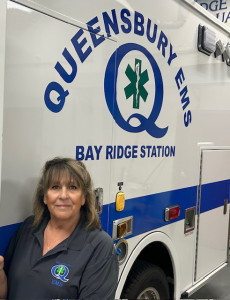
By Christine Graf
For the past 45 years, Constance “Conni” Tucker has been volunteering her time, serving the community as a member of the Bay Ridge Rescue Squad. Tucker joined the squad in 1979, receiving her EMS certification while attending nursing school. Working her way up the ladder, she was certified as a paramedic in the 1990s.
The daughter of a City of Glens Falls firefighter, Tucker describes herself as a “nurturer by trade.”
“When I was a kid, I brought home stray dogs, stray cats, stray people—anyone who needed help. That’s how I ended up in health care.”
After working as a board certified emergency room nurse for 25 years, Tucker left nursing, embarking on a career in real estate. A licensed real estate agent, she works for Howard Hanna Real Estate Services in Queensbury.
“I was suffering from significant burnout after being in the ER for so long, and I found that real estate was a different way of taking care of people,” she said.
Through it all, Tucker has remained a fixture at Bay Ridge, one of three ambulance squads that serve the Town of Queensbury. In 2023, two of the squads—Bay Ridge and North Queensbury—joined forces, now operating as one agency with a combined board of directors.
“It’s always been my hope that the three rescue squads in the Town of Queensbury would become one rescue squad. It’s a goal I have had a hand in working towards for over 20 years. By combining the agencies, you are able to give better care to the residents. That’s always been the goal,” said Tucker.
“It has worked out spectacularly. The residents of the Town of Queensbury are getting quality care from both rescue squads. West Glens Falls is still on its own, but we all have the same goal. And that is to give the best medical care that we can provide.”
The Queensbury EMS main station is located in the lower end of Queensbury, and its secondary station is located on the east side of Lake George. With two ambulances on the road at all times, they cover three fire districts. Each ambulance has both a paramedic and an EMT on board at all times.
“We have two full crews 24/7,” said Tucker. “They do 12-hour shifts. These guys are running their butts off doing 10 to 12 calls per shift. We’re doing well over 100 calls per month right now in the Town of Queensbury.”
A non-profit, the agency relies on taxpayer dollars and revenue recovery to fund operations.
“We bill in order to survive,” said Tucker. “You can’t ask the taxpayer to foot the bill for everyone especially in a resort area where you have a lot of people from out of town.”
Although grateful that EMS now receives funding from the town, Tucker said that has not always been the case.
“When we were an all-volunteer organization, we used to have to stand on the corner and beg for money. When Steve Borgos became the supervisor for the Town of Queensbury, he said, ‘No more standing on the corner. We’re going to start taking care of you.’”
Although the Queensbury EMS squad still relies on a small number of dedicated volunteers, its EMTs and paramedics hold paid positions. The pay ranges from approximately $20 to $26 an hour and does not include health insurance. Training to become an EMT or paramedic requires a significant investment of both time and money.
“When I became a paramedic, I didn’t have to pay a dime. The state paid for everything, but they don’t do that anymore,” said Tucker. “The paramedic program costs around $12,000 to $14,000, and it costs about $1,200 to become an EMT. We sometimes will pay for some of the training for our members.”
As someone who has worked in the field for more than 40 years, Tucker said she has witnessed it change significantly.
“The changes have been wonderful over the years. Before I became involved in EMS, it was ‘You Call. We Haul. That’s All.’ The ambulance came, they picked you up, they took you to the hospital. There was no advanced life support. Today, all of the agencies in Upstate New York provide excellent advanced life support care to people who need it.”
During Tucker’s long career in EMS, she has responded to thousands of calls, saving many lives in the process. Not all calls have had happy endings, and there are some she wishes she could forget.
“At the end of the day, when you are done with the call—regardless of whether it is a good call or a bad call–you know you’ve done your best, you’ve given it everything that you have, and you walk away with feeling of satisfaction that you gave someone the very best care that you could possibly give them,” she said.
“It’s very rewarding, and the good times outweigh the bad. When you treat a trauma patient that was really broken, you might see them a year later. They are back together and grateful for what you did for them.”
For those who feel called to the EMS field, Tucker encourages them to pursue it.
“If you are a nurturer and if you care for people and can handle the blood and guts, you should go for it. It’s a calling. When you have that calling, you need to follow it.”
